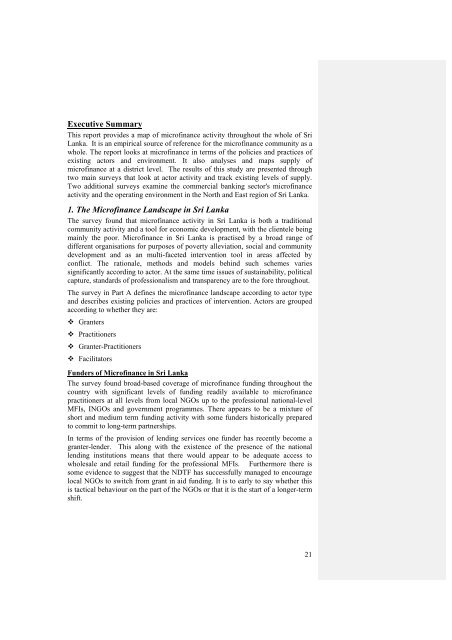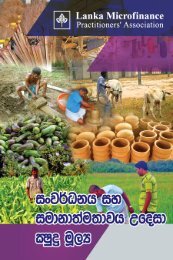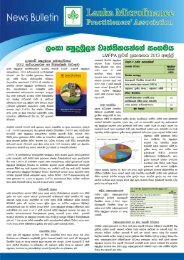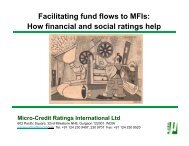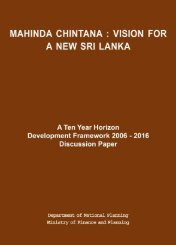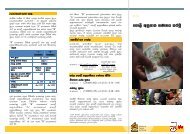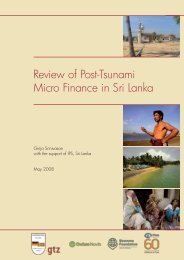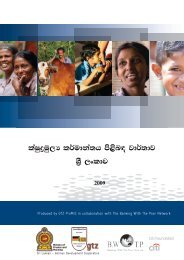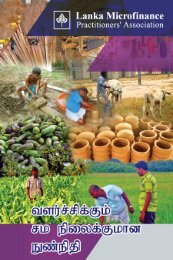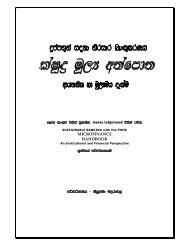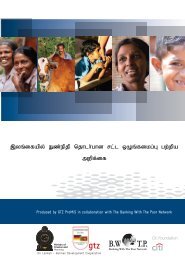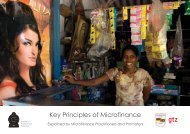National Microfinance Study of Sri Lanka: Survey of Practices and ...
National Microfinance Study of Sri Lanka: Survey of Practices and ...
National Microfinance Study of Sri Lanka: Survey of Practices and ...
Create successful ePaper yourself
Turn your PDF publications into a flip-book with our unique Google optimized e-Paper software.
Executive Summary<br />
This report provides a map <strong>of</strong> micr<strong>of</strong>inance activity throughout the whole <strong>of</strong> <strong>Sri</strong><br />
<strong>Lanka</strong>. It is an empirical source <strong>of</strong> reference for the micr<strong>of</strong>inance community as a<br />
whole. The report looks at micr<strong>of</strong>inance in terms <strong>of</strong> the policies <strong>and</strong> practices <strong>of</strong><br />
existing actors <strong>and</strong> environment. It also analyses <strong>and</strong> maps supply <strong>of</strong><br />
micr<strong>of</strong>inance at a district level. The results <strong>of</strong> this study are presented through<br />
two main surveys that look at actor activity <strong>and</strong> track existing levels <strong>of</strong> supply.<br />
Two additional surveys examine the commercial banking sector's micr<strong>of</strong>inance<br />
activity <strong>and</strong> the operating environment in the North <strong>and</strong> East region <strong>of</strong> <strong>Sri</strong> <strong>Lanka</strong>.<br />
1. The <strong>Micr<strong>of</strong>inance</strong> L<strong>and</strong>scape in <strong>Sri</strong> <strong>Lanka</strong><br />
The survey found that micr<strong>of</strong>inance activity in <strong>Sri</strong> <strong>Lanka</strong> is both a traditional<br />
community activity <strong>and</strong> a tool for economic development, with the clientele being<br />
mainly the poor. <strong>Micr<strong>of</strong>inance</strong> in <strong>Sri</strong> <strong>Lanka</strong> is practised by a broad range <strong>of</strong><br />
different organisations for purposes <strong>of</strong> poverty alleviation, social <strong>and</strong> community<br />
development <strong>and</strong> as an multi-faceted intervention tool in areas affected by<br />
conflict. The rationale, methods <strong>and</strong> models behind such schemes varies<br />
significantly according to actor. At the same time issues <strong>of</strong> sustainability, political<br />
capture, st<strong>and</strong>ards <strong>of</strong> pr<strong>of</strong>essionalism <strong>and</strong> transparency are to the fore throughout.<br />
The survey in Part A defines the micr<strong>of</strong>inance l<strong>and</strong>scape according to actor type<br />
<strong>and</strong> describes existing policies <strong>and</strong> practices <strong>of</strong> intervention. Actors are grouped<br />
according to whether they are:<br />
Granters<br />
Practitioners<br />
Granter-Practitioners<br />
Facilitators<br />
Funders <strong>of</strong> <strong>Micr<strong>of</strong>inance</strong> in <strong>Sri</strong> <strong>Lanka</strong><br />
The survey found broad-based coverage <strong>of</strong> micr<strong>of</strong>inance funding throughout the<br />
country with significant levels <strong>of</strong> funding readily available to micr<strong>of</strong>inance<br />
practitioners at all levels from local NGOs up to the pr<strong>of</strong>essional national-level<br />
MFIs, INGOs <strong>and</strong> government programmes. There appears to be a mixture <strong>of</strong><br />
short <strong>and</strong> medium term funding activity with some funders historically prepared<br />
to commit to long-term partnerships.<br />
In terms <strong>of</strong> the provision <strong>of</strong> lending services one funder has recently become a<br />
granter-lender. This along with the existence <strong>of</strong> the presence <strong>of</strong> the national<br />
lending institutions means that there would appear to be adequate access to<br />
wholesale <strong>and</strong> retail funding for the pr<strong>of</strong>essional MFIs. Furthermore there is<br />
some evidence to suggest that the NDTF has successfully managed to encourage<br />
local NGOs to switch from grant in aid funding. It is to early to say whether this<br />
is tactical behaviour on the part <strong>of</strong> the NGOs or that it is the start <strong>of</strong> a longer-term<br />
shift.<br />
21


